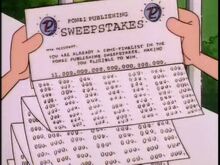A treseptuagintaquingentillion is equal to \(10^{1722}\) in the short scale and \(10^{3438}\) in the long scale by the Conway and Guy's naming system[1][2][3][4][5] as it is the 573rd -illion number.
In the long scale, \(10^{1722}\) is called septemoctogintaducentillion.[6]
Doug's Zillion[]

Screencap from the episode

Screencap from the episode

Screencap from the episode
\(10^{1,722}\) is also called Doug's Zillion. This number originates from an episode of the Nickelodeon animated cartoon Doug, titled "Doug's Mail Order Mania". In this episode, the title character enters a fraudulent sweepstakes which purports to offer this amount in US$ as a prize. Said number is repeatedly referred to as a "zillion" dollars. It is 1,723 digits long.
Notably, the number is written out in full in the episode, taking up several pages of paper. Although it's impossible to see the whole thing at once, the size of the number can be determined by counting the number of zeros on one visible page, multiplying it by the total number of zero-filled pages, and adding the 21 zeros on the first page.
This is quite possibly the largest number ever explicitly referenced in a cartoon.
Approximations[]
For the short scale:
| Notation | Lower bound | Upper bound |
|---|---|---|
| Scientific notation | \(1\times10^{1722}\) (exact) | |
| Arrow notation | \(10\uparrow 1722\) (exact) | |
| Steinhaus-Moser Notation | 617[3] | 618[3] |
| Chained arrow notation | \(10\rightarrow 1722\) (exact) | |
| Taro's multivariable Ackermann function | A(3,5717) | A(3,5718) |
| BEAF & Bird's array notation | {10,1722} (exact) | |
| Hyper-E notation | E1722 (exact) | |
| s(n) map | \(s(1)^3(\lambda x.x+1)(9)\) | \(s(1)^3(\lambda x.x+1)(10)\) |
| m(n) map | m(1)(617) | m(1)(618) |
| Bashicu matrix system | (0)(1)[3] | (0)(1)[4] |
| Copy notation | 9[1722] | 1[1723] |
| Pound-Star Notation | #*((18))*24 | #*((19))*24 |
| Hyperfactorial array notation | 711! | 712! |
| Fast-growing hierarchy | \(f_2(5707)\) | \(f_2(5708)\) |
| Hardy hierarchy | \(H_{\omega^2}(5707)\) | \(H_{\omega^2}(5708)\) |
| Slow-growing hierarchy | \(g_{\omega^{\omega^3+\omega^2 7+\omega 2+2}}(10)\) (exact) | |
For the long scale:
| Notation | Lower bound | Upper bound |
|---|---|---|
| Scientific notation | \(1\times10^{3438}\) (exact) | |
| Arrow notation | \(10\uparrow 3438\) (exact) | |
| Steinhaus-Moser Notation | 1126[3] | 1127[3] |
| Chained arrow notation | \(10\rightarrow 3438\) (exact) | |
| Taro's multivariable Ackermann function | A(3,11417) | A(3,11418) |
| BEAF & Bird's array notation | {10,3438} (exact) | |
| Hyper-E notation | E3438 (exact) | |
| s(n) map | \(s(1)^3(\lambda x.x+1)(10)\) | \(s(1)^3(\lambda x.x+1)(11)\) |
| m(n) map | m(1)(1126) | m(1)(1127) |
| Bashicu matrix system | (0)(1)[3] | (0)(1)[4] |
| Fast-growing hierarchy | \(f_2(11407)\) | \(f_2(11408)\) |
| Hardy hierarchy | \(H_{\omega^2}(11407)\) | \(H_{\omega^2}(11408)\) |
| Slow-growing hierarchy | \(g_{\omega^{\omega^3 3+\omega^2 4+\omega 3+8}}(10)\) (exact) | |
Sources[]
- ↑ Conway and Guy. (1995) "The book of Numbers" Copernicus
- ↑ Munafo, Robert. The Conway-Wechsler System. Retrieved 2023-03-20.
- ↑ Olsen, Steve. Big-Ass Numbers. Retrieved 2023-03-20.
- ↑ Fish. Conway's zillion numbers. Retrieved 2023-03-20.
- ↑ Fish. Conway's illion converter - 10^1722. Retrieved 2023-03-20.
- ↑ Fish. Conway's illion converter - 10^1722 (long scale). Retrieved 2023-03-20.
See also[]
10–19: decillion · undec · duodec · tredec · quattuordec · quindec · sexdec · septendec · octodec · novemdec
20–29: vigintillion · unvigint · duovigint · tresvigint · quattuorvigint · quinvigint · sesvigint · septemvigint · octovigint · novemvigint
30–39: trigintillion (un- · duo- · tres- · quattuor- · quin- · ses- · septen- · octo- · noven-)
40–49: quadragintillion (un- · duo- · tres- · quattuor- · quin- · ses- · septen- · octo- · noven-)
50–59: quinquagintillion (un- · duo- · tres- · quattuor- · quin- · ses- · septen- · octo- · noven-)
60–69: sexagintillion (un- · duo- · tre- · quattuor- · quin- · se- · septen- · octo- · noven-)
70–79: septuagintillion (un- · duo- · tre- · quattuor- · quin- · se- · septen- · octo- · noven-)
80–89: octogintillion (un- · duo- · tres- · quattuor- · quin- · sex- · septem- · octo- · novem-)
90–99: nonagintillion (un- · duo- · tre- · quattuor- · quin- · se- · septe- · octo- · nove-)
100–900: centillion · ducent · trecent · quadringent · quingent · sescent · septingent · octingent · nongent
1,000–1024: millillion · dumill · dumillinonagintanongent · trimill · trimilliduotrigintatrecent · trimillisexoctogintaoctingent · quadrimill · quadrimilliquattuordecicent · quinmill · sexmill · septimill · octimill · nonimill · myr · decimilliquinsexagintasescent · dumyr · unquadragintamilliunquinquagintacent · centimill · micr · nan · pic · femt · att · zept · yoct
510–519: deciquingentillion (un- · duo- · tre- · quattuor- · quin- · se- · septen- · octo- · noven-)
520–529: vigintiquingentillion (un- · duo- · tres- · quattuor- · quin- · ses- · septem- · octo- · novem-)
530–539: trigintaquingentillion (un- · duo- · tres- · quattuor- · quin- · ses- · septen- · octo- · noven-)
540–549: quadragintaquingentillion (un- · duo- · tres- · quattuor- · quin- · ses- · septen- · octo- · noven-)
550–559: quinquagintaquingentillion (un- · duo- · tres- · quattuor- · quin- · ses- · septen- · octo- · noven-)
560–569: sexagintaquingentillion (un- · duo- · tre- · quattuor- · quin- · se- · septen- · octo- · noven-)
570–579: septuagintaquingentillion (un- · duo- · tre- · quattuor- · quin- · se- · septen- · octo- · noven-)
580–589: octogintaquingentillion (un- · duo- · tres- · quattuor- · quin- · sex- · septem- · octo- · novem-)
590–599: nonagintaquingentillion (un- · duo- · tre- · quattuor- · quin- · se- · septe- · octo- · nove-)
